What is trap defense in basketball
Trap defense is a tactic that occurs when two defensive players effectively double team one offensive player in current possession of the basketball, typically near a sideline and/or corner of the court.
The primary purpose of implementing a trap defense is to cause turnovers, which could diminish scoring opportunities for the offensive team.
What are advantages of trap defense
One advantage of trap defense is that it can cause the offensive team in general, and more specifically, the player in possession of the ball to make quicker decisions than usual. This could lead to turnovers such as defensive interceptions via bad passes.
Another advantage of the trap defense is that it could be utilized as a method of the defensive team generating points, primarily via transition offense.
This could be very beneficial for defensive teams that cannot shoot very well from the perimeter because those teams could score via transition layups from the offensive turnovers.
What are disadvantages of trap defense
One disadvantage of trap defense is that in many instances, at least one offensive player would always be open to receive the ball from the player caught in the trap.
So, if that trapped player has the skill and capability to pass out of the trap, then the offensive teammate receiving the ball would have the opportunity to score or make plays for other teammates.
Another disadvantage is that the middle area within the trap defense could become vulnerable, particularly if a non-trap defender does not cover that space on the court.
For example, if an offensive player with the ball gets trapped near the sideline or corner, that same player could potentially break the trap by quickly passing the ball to another teammate in the middle of the court.
What are general concepts to consider for trap defense
Navigate the ball handler towards a sideline/corner
During the initial phases of the trap sequence, one of the defenders, particularly at the front of the trap should navigate (or push) the ball handler towards a sideline or corner.
When this occurs, the trap could be set more effectively and the defense would be able to use the sideline/corner as another defender.
Protect the middle
As mentioned previously, if the trapped player can pass the ball into the middle of the trap, then this could cause a defensive breakdown which could lead to easy scoring opportunities for the offensive team.
Therefore, when the defender at the front of the trap pushes the ball handler towards a sideline/corner, another defender, particularly on the weak side of the court, should slide into the middle space of the trap defense to deny and/or prevent a pass into that area.
Have active hands when setting the trap but do not foul
When an offensive player gets caught in the trap, the two trap defenders should not reach in to steal the ball or make any other unnecessary foul.
Instead, the two defenders should simply have active hands which mirror the hands of the trapped player with the ball.
For example, if the trapped player tries to execute an overhead pass to another teammate, then the trap defenders should have high hands above the shoulders and/or head.
Likewise, if the trapped player attempts to execute a bounce pass to another teammate, then the trap defenders should have lower hands below the waist near the legs.
By having active hands, the trap defenders could either deflect the ball so that another teammate could intercept it or one of the trap defenders could intercept the ball themselves.
Also, in some instances, the trapped player could potentially panic and throw a bad pass out of bounds because that player could not see any available teammates due to the active hands of the trap defenders.
What are the different types of systems or strategies that use trap defense principles
Full court press
The full court press seeks to trap the ball, preferably in the backcourt, and cause turnovers which could lead to easy scoring opportunities via transition layups.
Half court press
Generally speaking, the half court press emphasizes setting traps in various corners, especially within the offensive team’s frontcourt, which could lead to turnovers and transition layups.
Zone defense
Certain types of zone defense can utilize trap defense principles while still focusing on protecting the basket and influencing jump shots.
Essentially, within certain types of zones, the traps are typically set near the wing sideline area or in the corners by the baseline. However, it is also possible to set extended traps at the top.
Baseline Trap
The baseline trap typically occurs when the player in possession of the basketball dribbles it towards the baseline when there are two or more defenders adjacent to each other on that side of the court.
A good time to generally implement the baseline trap is when the ball handler beat their defender with the dribble and begins to drive baseline towards the basket.
A help defender, usually a low post player could contain (assuming the other weak side defenders are able to rotate correctly) until the ball handler’s defender catches up from behind.
Afterwards, the help defender and the original defender could set the trap near the baseline.
Ball Screen Trap
The ball screen trap could be implemented as a defensive counter to an offensive team’s on-ball screens, particularly near the top or the wings.
The ball screen trap typically occurs when the screener’s defender executes a type of hard hedge that pushes the ball handler towards the sideline while the ball handler’s defender fights through the screen and chases from behind.
Once the ball handler’s defender catches up to the ball handler, both defenders trap the ball and take away potential passes with active hands.
Additionally, any strong side defenders should execute deny defense while weak side defenders rotate into proper help positions.
Related: Trapping The Ball Screen – YouTube
What are simple examples of trap defense
1-2-1-1 Full Court Trap Example – Part 1

This is a simplified example of the 1-2-1-1 full court trap, also known as the 1-2-1-1 full court press. 1 receives the ball from 4 and when that occurs, X4 begins to push 1 towards a sideline.
At the same time, X3 cuts off the pathway from the middle to keep 1 near the sideline. Also, X1 cuts over towards the sideline and X2 cuts over towards the free throw line area near the high post.
1-2-1-1 Full Court Trap Example – Part 2
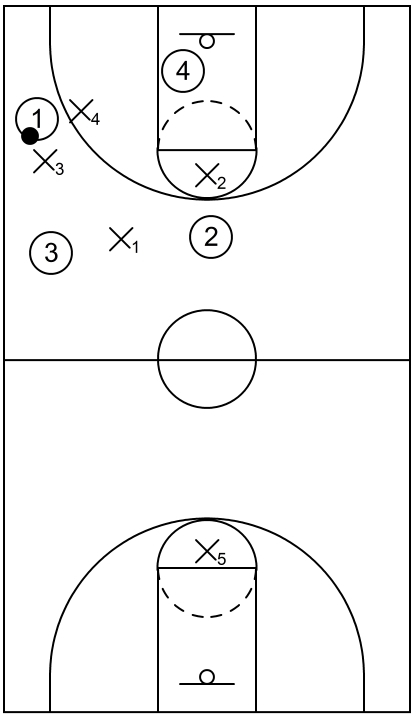
At this point, X3 and X4 have successfully trapped 1 near the sideline. Also, 2 and 3 are added to the example for demonstration purposes.
X1 splits the difference between 2 and 3 and can intercept the ball if 3 is the receiving target from 1. At the same time, X2 could intercept the ball if 2 is the receiving target from 1.
1-2-2 Half Court Trap Example – Part 1
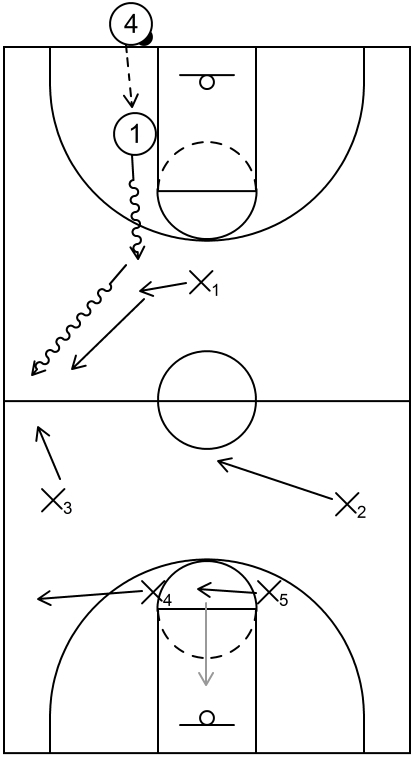
This is a simplified example of the 1-2-2 half court trap. 1 begins to dribble towards the frontcourt after receiving the ball from 4. However, as that happens, X1 begins to push 1 towards the sideline.
At the same time, X3 slides up to initiate the trap while X2 slides over to cover the middle of the court. X4 also slides over towards the sideline while X5 slides over to the free throw line area near the high post.
Additionally, X5 could also drop back towards the basket, shown with the gray arrow if one or more offensive players move towards the corners or low post areas.
1-2-2 Half Court Trap Example – Part 2
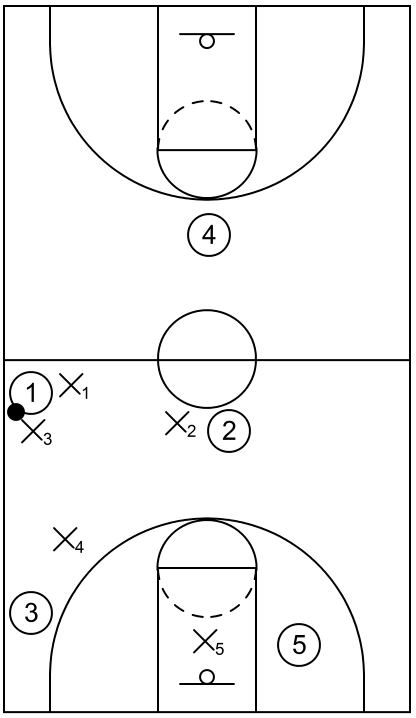
At this point, X1 and X3 have successfully trapped 1 near the corner. Ideally, the trap should be set in the frontcourt corner. That way, 1 cannot reverse the ball to 4 as that would be a backcourt violation.
Also, X2 covers the middle and could deflect or intercept the ball if 2 is the receiving target. Similarly, X4 covers the sideline and could deflect or intercept the ball if 3 is the receiving target.
Additionally, X5 drops back to protect the basket as 5 cuts to the low post block below the free throw line area.
1-3-1 Zone Trap Example – Part 1
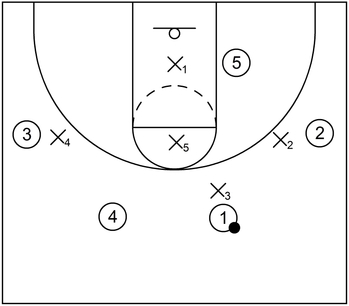
This is an example of the 1-3-1 zone trap defense when the ball is at the top.
To start, X3 should apply on-ball defensive pressure while X2 and X4 cover the wing areas. Also, X5 covers the high post area and X1 stays near the back of the zone.
1-3-1 Zone Trap Example – Part 2

This is an example of the 1-3-1 trap zone defense when the ball gets passed to the wing and there is also an empty strong side corner.
When that occurs, X1 and X3 could trap the ball handler near the wing to either cause a potential turnover or to influence ball reversal back towards the top.
At the same time, X5 drops back to cover the low post area while X3 drops back to cover the free throw area near the high post. X4 also drops back near the mid-post area to watch for any weak side offensive action.
1-3-1 Zone Trap Example – Part 3
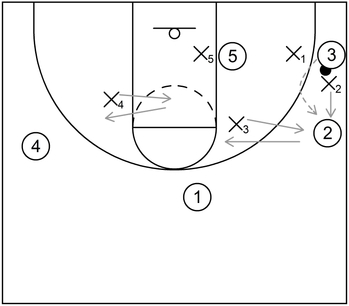
This is an example of the 1-3-1 trap zone when the ball gets passed to the corner. When that occurs, X1 and X2 could trap the ball handler near the corner while X5 continues to cover the low post area.
Additionally, if 2 receives the ball from 3, then X3 could temporarily stunt at the ball by with a closeout towards the right side wing.
Furthermore, X4 could temporarily step into the lane to provide extra lane protection to mitigate potential cutting by 1 at the top or 4 on the weak side.
Once X2 recovers back to the right side wing wing area, X3 would return back to the free throw area near the high post and X4 would return to the weak side mid-post area. These alternative actions are represented by gray arrows on the diagram.
1-3-1 Zone Trap Example – Part 4
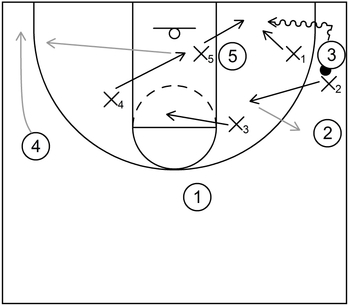
This is an example of the 1-3-1 trap zone defense if the ball handler in the corner executes dribble penetration towards the baseline. When that occurs, X5 could drop towards the baseline to set a trap with X1.
At the same time, X4 should quickly drop back into the lane to protect the basket and cover 5 near the right side low post block. Also, X3 could drop back slightly below the free throw area to watch for potential cutting action by 1.
Furthermore, X2 could step back from the corner trap position towards the mid-post extended area. From that point, if X3 makes a pivot pass out of the trap towards 2 on the right side wing, X2 would be able to closeout to contest the jump shot or slow down dribble penetration, shown with the gray arrow.
Also, if 4 cuts down to the left side corner and received the drift pass out of the trap from 3, then X4 would have to quickly sprint to closeout and contest the potential jump shot, also shown with the gray arrow.